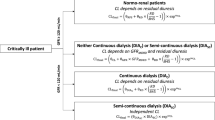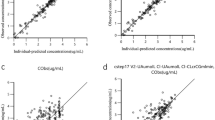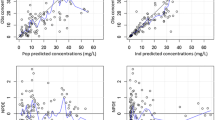Abstract
Purpose
Patients admitted to intensive care unit (ICU) with Klebsiella pneumoniae infections are characterized by high mortality. The aims of the present study were to investigate the population pharmacokinetics parameters and to assess the probability of target attainment of meropenem in critically ill patients to provide information for more effective regimens.
Methods
Twenty-seven consecutive patients were included in the study. Meropenem was administered as 3-h intravenous (i.v.) infusions at doses of 1–2 g every 8 or 12 h. Meropenem plasma concentrations were measured by a high-performance liquid chromatography (HPLC) method, and a population pharmacokinetics analysis was performed using NONMEM software. Meropenem plasma disposition was simulated for extended (3 h; 5 h) or continuous i.v. infusions, and the following parameters were calculated: time during which free drug concentrations were above minimum inhibitory concentration (MIC) (fT > MIC), free minimum plasma concentrations above 4× MIC (fCmin > 4× MIC), probability of target attainment (PTA), and cumulative fraction of response (CFR).
Results
Gender and severity of sepsis affected meropenem clearance, whose typical population values ranged from 6.22 up to 12.04 L/h (mean ± standard deviation (SD) value, 9.38 ± 4.47 L/h). Mean C min value was 7.90 ± 7.91 mg/L, suggesting a high interindividual variability. The simulation confirmed that 88 and 97.5 % of patients achieved effective C min > 4× MIC values after 3- and 5-h i.v. infusions of meropenem 2 g × 3/day, respectively. On the contrary, the same total daily doses reached the target C min > 4× MIC values in 100 % of patients when administered as continuous i.v. infusions.
Conclusions
Several factors may influence meropenem pharmacokinetics in ICU patients. Continuous i.v. infusions of meropenem seem to be more effective than standard regimens to achieve optimal therapeutic targets.



Similar content being viewed by others
References
Binder L, Schwörer H, Hoppe S, Streit F, Neumann S, Beckmann A, et al. (2013) Pharmacokinetics of meropenem in critically ill patients with severe infections. Ther Drug Monit 35:63–70
Udy AA, Roberts JA, Lipman J (2013) Clinical implications of antibiotic pharmacokinetic principles in the critically ill. Intensive Care Med 39:2070–2082
Drusano GL, Hutchison M (1995) The pharmacokinetics of meropenem. Scand J Infect Dis Suppl 96:11–16
European Medicines Agency (2009) Meropenem summary of product characteristics http://www.ema.europa.eu/docs/en_GB/document_library/Referrals_document/Meronem_30/WC500018555.pdf. Accessed 2 April 2015
Jaruratanasirikul S, Limapichat T, Jullangkoon M, Aeinlang N, Ingviya N, Wongpoowarak W (2011) Pharmacodynamics of meropenem in critically ill patients with febrile neutropenia and bacteraemia. Int J Antimicrob Agents 38:231–236
Lomaestro BM, Drusano GL (2005) Pharmacodynamic evaluation of extending the administration time of meropenem using a Monte Carlo simulation. Antimicrob Agents Chemother 49:461–463
MacGowan A (2011) Revisiting beta-lactams—PK/PD improves dosing of old antibiotics. Curr Opin Pharmacol 11:470–476
Mouton JW, Dudley MN, Cars O, Derendorf H, Drusano GL (2005) Standardization of pharmacokinetic/pharmacodynamic (PK/PD) terminology for anti-infective drugs: an update. J Antimicrob Chemother 55:601–607
Drusano GL (2003) Prevention of resistance: a goal for dose selection for antimicrobial agents. Clin Infect Dis 36(Suppl. 1):S42–S50
Craig WA (1998) Pharmacokinetic/pharmacodynamic parameters: rationale for antibacterial dosing of mice and men. Clin Infect Dis 26:1–10
Blot SI, Pea F, Lipman J (2014) The effect of pathophysiology on pharmacokinetics in the critically ill patient–concepts appraised by the example of antimicrobial agents. Adv Drug Deliv Rev 77:3–11
Roberts JA, Ulldemolins M, Roberts MS, McWhinney B, Ungerer J, Paterson DL, et al. (2010) Therapeutic drug monitoring of beta-lactams in critically ill patients: proof of concept. Int J Antimicrob Agents 36:332–339
De Waele JJ, Carrette S, Carlier M, Stove V, Boelens J, Claeys G, et al. (2014) Therapeutic drug monitoring-based dose optimisation of piperacillin and meropenem: a randomized controlled trial. Intensive Care Med 40:380–387
Crandon JL, Ariano RE, Zelenitsky SA, Nicasio AM, Kuti JL, Nicolau DP (2011) Optimization of meropenem dosage in the critically ill population based on renal function. Intensive Care Med 37:632–638
Roberts JA, Kirkpatrick CM, Roberts MS, Robertson TA, Dalley AJ, Lipman J (2009) Meropenem dosing in critically ill patients with sepsis and without renal dysfunction: intermittent bolus versus continuous administration? Monte Carlo dosing simulations and subcutaneous tissue distribution. J Antimicrob Chemother 64:142–150
Levy MM, Fink MP, Marshall JC, Abraham E, Angus D, Cook D, et al. (2003) 2001 SCCM/ESICM/ACCP/ATS/SIS International sepsis definitions Conference. Intensive Care Med 31(4):1250–1256
CLSI (2012) Performance standards for antimicrobial susceptibility testing: twenty-second Informational Supplement. CLSI document M100–22. Wayne, PA, Clinical and Laboratory Standards Institute
Legrand T, Chhun S, Rey E, Blanchet B, Zahar JR, Lanternier F, et al. (2008) Simultaneous determination of three carbapenem antibiotics in plasma by HPLC with ultraviolet detection. J Chromatogr B Analyt Technol Biomed Life Sci 875:551–556
International Conference on Harmonization (ICH). Harmonised tripartite guideline: validation of analytical procedures: text and methodology Q2(R1) 6 1996. ICH Official web site Available: http://www.ich.org. Accessed 8 May 2015
Shah VP, Midha KK, Dighe S (1992) Conference report: analytical methods validation: bioavailability, bioequivalence, and pharmacokinetic studies. J Pharm Sci-US 81:309–312
Beal SL, Sheiner LB, Boeckmann AJ (2009) NONMEM users guides. Ellicott City, MD:ICON Development Solutions 1989
Jonsson EN, Karlsson MO (1999) Xpose—an S-PLUS based population pharmacokinetic/pharmacodynamic model building aid for NONMEM. Comput Methods Prog Biomed 58:51–64
Lindbom L, Ribbing J, Jonsson EN (2004) Perl-speaks-NONMEM (PsN)—a Perl module for NONMEM related programming. Comput Methods Prog Biomed 75:85–94
Bergstrand M, Hooker AC, Wallin JE, Karlsson MO (2011) Prediction-corrected visual predictive checks for diagnosing nonlinear mixed-effects models. AAPS J 13:143–151
Mouton JW, Punt N (2001) Use of the t > MIC to choose between different dosing regimens of beta-lactam antibiotics. J Antimicrob Chemother 47:500–501
European Committee on Antimicrobial Susceptibility Testing (2016) Data from the EUCAST MIC distribution website, http://www.eucast.org. Accessed February 25, 2015
Knaus WA, Draper EA, Wagner DP, Zimmerman JE (1985) APACHE II: a severity of disease classification system. Crit Care Med 13:818–829
Le Gall JR, Lemeshow S, Saulnier F (1993) A new Simplified Acute Physiology score (SAPS II) based on a European/North American multicenter study. JAMA 270:2957–2963
Charlson ME, Pompei P, Ales KL, MacKenzie CR (1987) A new method of classifying prognostic comorbidity in longitudinal studies: development and validation. J Chronic Dis 40:373–383
Zhou QT, He B, Zhang C, Zhai SD, Liu ZY, Zhang J (2011) Pharmacokinetics and pharmacodynamics of meropenem in elderly Chinese with lower respiratory tract infections: population pharmacokinetics analysis using nonlinear mixed-effects modelling and clinical pharmacodynamics study. Drugs Aging 28:903–912
Novelli A, Adembri C, Livi P, Fallani S, Mazzei T, De Gaudio AR (2005) Pharmacokinetic evaluation of meropenem and imipenem in critically ill patients with sepsis. Clin Pharmacokinet 44:539–549
Pea F, Viale P (2009) Bench-to-bedside review: appropriate antibiotic therapy in severe sepsis and septic shock-dose the dose matter? Crit Care 32:214
Sinnollareddy MG, Roberts MS, Lipman J, Roberts JA (2012) β-lactam pharmacokinetics and pharmacodynamics in critically ill patients and strategies for dose optimization: a structured review. Clin Exp Pharmacol Physiol 39:489–496
Goncalves-Pereira J, Silva NE, Mateus A, Pinho C, Povoa P (2014) Assessment of pharmacokinetic changes of meropenem during therapy in septic critically ill patients. BMC Pharmacol Toxicol 15:21
Jaruratanasirikul S, Thengyai S, Wongpoowarak W, Wattanavijitkul T, Tangkitwanitjaroen K, Sukarnjanaset W, et al. (2015) Population pharmacokinetics and Monte Carlo dosing simulations of meropenem during the early phase of severe sepsis and septic shock in critically ill patients in intensive care units. Antimicrob Agents Chemother 59:2995–3001
Thalhammer F, Traunmüller F, EI Menyawi I, Frass M, Hollenstein UM, Locker GJ, et al. (1999) Continuous infusion versus intermittent administration of meropenem in critically ill patients. J Antimicrob Chemother 43:523–527
Chytra I, Stepan M, Benes J, Pelnar P, Zidkova A, Bergerova T, et al. (2012) Clinical and microbiological efficacy of continuous versus intermittent application of meropenem in critically ill patients: a randomized open-label controlled trial. Crit Care 16:R113
Kuti JL, Nightingale CH, Knauft RF, Nicolau DP (2004) Pharmacokinetic properties and stability of continuous-infusion meropenem in adults with cystic fibrosis. Clin Ther 26:493–501
Taccone FS (2012) Continuous infusion of meropenem in critically ill patients: practical considerations. Crit Care 16:444
Tumbarello M, Viale P, Viscoli C, Trecarichi EM, Tumietto F, Marchese A, et al. (2012) Predictors of mortality in bloodstream infections caused by Klebsiella pneumoniae carbapenemase-producing K. pneumoniae: importance of combination therapy. Clin Infect Dis 55:943–950
Acknowledgments
The authors should thank the patients, their relatives, and nurse staff for their invaluable support in this study.
Author’s contribution
Authors | Conception and design of study | Acquisition of data: laboratory or clinical | Analysis of data | Drafting of article and/or critical revision | Final approval of manuscript |
|---|---|---|---|---|---|
Francesca Mattioli | X | X | X | X | |
Carmen Fucile | X | X | X | X | |
Valerio Del Bono | X | X | X | ||
Valeria Marini | X | X | |||
Andrea Parisini | X | X | X | ||
Alexandre Molin | X | X | X | ||
Maria Laura Zuccoli | X | X | |||
Giulia Milano | X | X | |||
Romano Danesi | X | X | |||
Anna Marchese | X | X | |||
Marialuisa Polillo | X | X | |||
Claudio Viscoli | X | X | |||
Paolo Pelosi | X | X | |||
Antonietta Martelli | X | X | |||
Antonello Di Paolo | X | X | X | X |
Author information
Authors and Affiliations
Corresponding author
Ethics declarations
All procedures performed in studies involving human participants were in accordance with the ethical standards of the institutional and/or national research committee and with the 1964 Helsinki declaration and its later amendments or comparable ethical standards. Informed consent was obtained from all individual participants included in the study.
Disclosure
The study did not provide any source of funding by sponsor.
Conflict of interest
Antonello Di Paolo is a board member for Novartis Pharma Spa. The other authors have none to declare.
Headings
- Meropenem pharmacokinetics is highly variable in ICU patients with severe infections, and some patients do not achieve effective meropenem plasma concentrations.
- The severity of infection does influence the pharmacokinetics of meropenem.
- Meropenem efficacy could be increased by the adoption of continuous infusions.
Electronic supplementary material
ESM 1
(DOCX 17 kb)
Rights and permissions
About this article
Cite this article
Mattioli, F., Fucile, C., Del Bono, V. et al. Population pharmacokinetics and probability of target attainment of meropenem in critically ill patients. Eur J Clin Pharmacol 72, 839–848 (2016). https://doi.org/10.1007/s00228-016-2053-x
Received:
Accepted:
Published:
Issue Date:
DOI: https://doi.org/10.1007/s00228-016-2053-x




